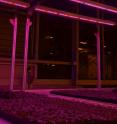Light-emitting diode sole-source lighting effective in bedding plant seedling production
In northern latitudes, producers of bedding plants depend on supplemental lighting during the late winter and early spring growing seasons. Unfortunately, these peak times for young plant production are also the darkest. Researchers have determined that a minimum amount of photosynthetic light (daily light integral; DLI) is necessary to produce high-quality young plants in greenhouses. In northern latitudes, though, the average greenhouse photosynthetic DLI can fall far short of optimal levels, resulting in delayed production and poor quality plants. Roberto Lopez and Wesley Randall, researchers at the Department of Horticulture and Landscape Architecture at Purdue University, published a study in the May 2015 issue of HortScience in which they compared the quality of bedding plant seedlings grown under sole-source LEDs and supplemental lighting from LEDs and high-pressure sodium lamps. "Due to their small size, wavelength specificity, high light output, and relatively low heat output, LEDs have been used in environmental chambers for sole-source photosynthetic lighting and now in greenhouses as overhead supplemental lighting for young ornamental plants," Lopez said.
Lopez and Randall compared bedding plant seedlings grown under low greenhouse ambient light (AL) to those grown under supplemental lighting (SL) or sole-source photosynthetic (SSL) with a similar DLI. The researchers used seeds of French marigold, geranium, impatiens, petunia, and vinca sown into seed trays filled with soilless medium and then placed in a glass-glazed greenhouse. Trays of each species were moved upon hypocotyl emergence to one of three treatments: ambient light, ambient light plus supplemental light in a glass-glazed greenhouse, or sole-source photosynthetic light in a growth chamber. After the lighting treatments, seedlings from each tray were transplanted into containers filled with soilless medium and placed in a common greenhouse environment with a 16-hour photoperiod of ambient light supplemented with high-pressure sodium lamps.
"Our results showed that the bedding plant seedlings grown under SSL were of similar or greater quality compared with those under SL, indicating that LED SSL could be used as an alternative to traditional greenhouse seedling production," Lopez and Randall said.
"Supplemental and SSL with blue light are known to suppress extension growth and leaf expansion, resulting in compact young plants, which is often a desirable characteristic for greenhouse growers," the authors noted. "A general recommendation for SSL of bedding plant seedlings would be to include anywhere from 10% to 30% blue light depending on the desired crop-specific attributes and costs."
The researchers added that LEDs could be used for SSL in high-density multilayer production systems as an effective alternative in greenhouse annual bedding plant seedling production.
Source: American Society for Horticultural Science
Articles on the same topic
- Astronomers discover powerful aurora beyond solar systemWed, 29 Jul 2015, 19:02:17 UTC
- Failed stars host powerful aurora displaysWed, 29 Jul 2015, 19:02:08 UTC
- 'Failed stars' host powerful auroral displaysWed, 29 Jul 2015, 19:01:55 UTC
Other sources
- Brown Dwarf Boasts Brightest Auroras Ever Seen [Slide Show]from Scientific AmericanMon, 3 Aug 2015, 14:30:31 UTC
- Brown dwarf's powerful auroras shine brightfrom Physics WorldFri, 31 Jul 2015, 21:50:17 UTC
- Powerful Auroras Found at Brown Dwarffrom NASA Jet Propulsion LaboratoryFri, 31 Jul 2015, 18:20:11 UTC
- Powerful aurora spotted on distant brown dwarffrom UPIThu, 30 Jul 2015, 13:30:15 UTC
- Auroras spotted outside solar system for first timefrom CBC: Technology & ScienceThu, 30 Jul 2015, 13:00:11 UTC
- Aurora found beyond our Solar Systemfrom BBC News: Science & NatureThu, 30 Jul 2015, 0:00:12 UTC
- A First: Scientists Spot Aurora Outside Our Solar Systemfrom MSNBC: ScienceWed, 29 Jul 2015, 23:30:20 UTC
- First Alien Auroras Found, Are 1 Million Times Brighter Than Any On Earthfrom Space.comWed, 29 Jul 2015, 19:20:13 UTC
- Outer space aurora puts Northern Lights to shamefrom CBSNews - ScienceWed, 29 Jul 2015, 19:00:17 UTC
- 'Failed stars' host powerful auroral displaysfrom Science DailyWed, 29 Jul 2015, 18:50:28 UTC
- Brown dwarf aurora found; could inform exoplanet searchesfrom LA Times - ScienceWed, 29 Jul 2015, 18:30:15 UTC
- Brown dwarf stars host powerful aurora displays, astronomers discoverfrom PhysorgWed, 29 Jul 2015, 17:30:21 UTC
- First 'northern lights' seen outside the solar systemfrom Science NOWWed, 29 Jul 2015, 17:20:13 UTC
- Light-emitting diode sole-source lighting effective in bedding plant seedling productionfrom PhysorgWed, 29 Jul 2015, 16:31:01 UTC
- End-of-production LED lighting increases red pigmentation in lettucefrom PhysorgWed, 29 Jul 2015, 16:30:56 UTC
- Ugly Ducklings of the Universe are Born Like Starsfrom Scientific AmericanWed, 29 Jul 2015, 13:50:06 UTC
